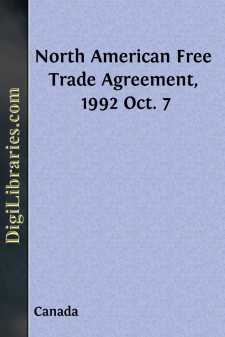Categories
- Antiques & Collectibles 13
- Architecture 36
- Art 48
- Bibles 22
- Biography & Autobiography 813
- Body, Mind & Spirit 141
- Business & Economics 28
- Children's Books 12
- Children's Fiction 9
- Computers 4
- Cooking 94
- Crafts & Hobbies 4
- Drama 346
- Education 46
- Family & Relationships 57
- Fiction 11826
- Games 19
- Gardening 17
- Health & Fitness 34
- History 1377
- House & Home 1
- Humor 147
- Juvenile Fiction 1873
- Juvenile Nonfiction 202
- Language Arts & Disciplines 88
- Law 16
- Literary Collections 686
- Literary Criticism 179
- Mathematics 13
- Medical 41
- Music 40
- Nature 179
- Non-Classifiable 1768
- Performing Arts 7
- Periodicals 1453
- Philosophy 64
- Photography 2
- Poetry 896
- Political Science 203
- Psychology 42
- Reference 154
- Religion 513
- Science 126
- Self-Help 83
- Social Science 81
- Sports & Recreation 34
- Study Aids 3
- Technology & Engineering 59
- Transportation 23
- Travel 463
- True Crime 29
North American Free Trade Agreement, 1992 Oct. 7
by: Canada
Description:
Excerpt
1. The Schedule of a Party sets out the reservations taken by that Party, pursuant to Articles 1108(1) and 1206(2), with respect to existing, non-conforming measures that derogate from an obligation relating to:
(a) national treatment, pursuant to Article 1102 (Investment)
or 1202 (Services);
(b) most-favored-nation treatment, pursuant to Article 1103
(Investment) or 1203 (Services);
(c) local presence, pursuant to Article 1205 (Services);
(d) performance requirements, pursuant to Article 1106 (Investment); or
(e) nationality requirements for senior management or members of boards of directors, pursuant to Article 1107 (Investment).
2. Each reservation sets out the following elements (ftnt 1):
(a) SECTOR refers to the general sector in which the
reservation is taken;
(b) SUB-SECTOR refers to the specific sector in which the
reservation is taken;
(c) INDUSTRY CLASSIFICATION refers to the activity, where applicable, covered by the reservation according to domestic industry classification codes;
(d) TYPE OF RESERVATION specifies the obligation referred to in paragraph 1 for which a reservation is taken;
(e) LEVEL OF GOVERNMENT indicates the level of government
maintaining the measure for which the Party is taking the
reservation;
(f) LEGAL CITATION identifies the specific existing measures,
where applicable, for which the reservation is taken;
(ftnt 2)
(g) DESCRIPTION describes the non-conforming aspects of the existing measures for which the reservation is taken and, where applicable, commitments for liberalization upon entry into force of this Agreement; and
(h) DURATION sets out the period for which the reservation is taken and the phase-in of commitments for liberalization.
3. In the interpretation of a reservation, all elements of the reservation should be considered. Where the DURATION does not provide for liberalization, the LEGAL CITATION shall govern to the extent of any inconsistency with any other element. Where the DURATION provides for liberalization upon or after entry into force of this Agreement, the DURATION shall govern to the extent of any inconsistency with any other element.
4. Where a Party maintains a measure that requires that a service provider be a citizen, permanent resident or resident of its territory as a condition to the provision of a service in its territory, a reservation for Articles 1202, 1203 or 1205 taken with respect to that measure shall operate as a reservation for Articles 1102 or 1103 with respect to the effect of that measure on the ability of the service provider to establish an investment.
5. For purposes of this Annex:
CMAP means Clasificación Mexicana de Actividades y Productos;
concession means an authorization provided by the State to a person to exploit a natural resource or provide a service, for which Mexican nationals and Mexican enterprises are granted priority over foreigners;
CPC means Central Product Classification numbers as set out in
Statistical Office of the United Nations, Statistical Papers,
Series M, No. 77, Provisional Central Product Classification,
1991;
foreigners' exclusion clause means the express provision in an enterprise's by-laws, stating that the enterprise shall not allow foreigners, directly or indirectly, to become partners or shareholders of the enterprise;
international cargo means goods that have an origin or destination outside the territory of a Party;
Mexican enterprise means an enterprise constituted under the laws of Mexico;
Mexican national means a national of Mexico, as defined by the
Constitution of Mexico;
person of a Party means a national or an enterprise of a Party; and
SIC means:
(a) with respect to Canada, Standard Industrial
Classification (SIC) numbers as set out in Statistics
Canada, Standard Industrial Classification, fourth
edition, 1980; and
(b) with respect to the United States, Standard Industrial
Classification (SIC) numbers as set out in the United
States Office of Management and Budget, Standard
Industrial Classification Manual, 1987....












